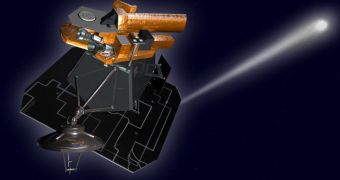Ahead of a planned November 4 flyby of the Comet Hartley 2, the NASA EPOXI mission discovered a new and unexpected phenomenon taking place on the space body.
Researchers were puzzled to discover that the object began releasing large amounts of cyanide without increasing its dust emissions, all over a period of 8 days. This type of behavior was never recorded in a comet before.
The EPOXI mission is made up of the former Deep Impact spacecraft, which first visited the comet 9P/Tempel some five years ago. After the success of the previous mission, the probe has been reassigned to the new task.
It has been trailing Hartley 2 for some time, and experts at the NASA Jet Propulsion Laboratory (JPL), in Pasadena, California calculated that the two will meet up at the point of closest approach this November.
As EPOXI is trailing its target, investigators noticed that deadly cyanide gas was being released in much larger quantities as the spacecraft was approaching the Sun than in any other conditions.
“On Earth, cyanide is known as a deadly gas. In space it's known as one of the most easily observed ingredients that is always present in a comet,” explains space expert Mike A'Hearn.
“Our observations indicate that cyanide released by the comet increased by a factor of five over an eight-day period in September without any increase in dust emissions,” the scientist adds.
“We have never seen this kind of activity in a comet before, and it could affect the quality of observations made by astronomers on the ground,” he details further.
A'Hearn is the principal investigator of the EPOXI mission, and he holds an appointment at the University of Maryland in College Park.
Typically, he says, when comets have outbursts of material, the phenomenon is accompanied by an increase in the amount of dust particles the body leaves in its wake.
The expert urges caution for amateur and professional astronomers alike, in interpreting the data they collect of Hartley 2 under these circumstances.
“If observers monitoring Hartley 2 do not take into account this new phenomenon, they could easily get the wrong picture of how the comet is changing as it approaches and recedes from the Sun,” he says.
Hartley 2 passed closest to the Earth on October 20, and is currently heading deeper into the solar system. A large number of ground- and space-based telescopes are trained on it.

 14 DAY TRIAL //
14 DAY TRIAL //